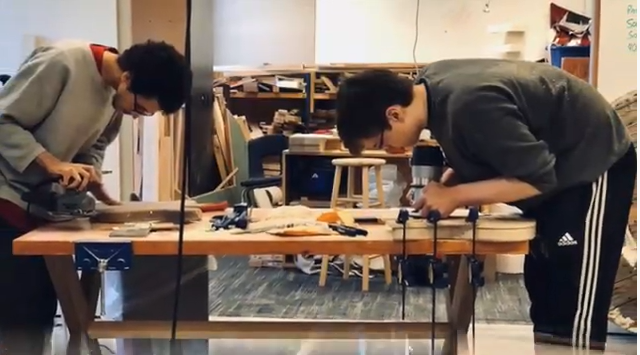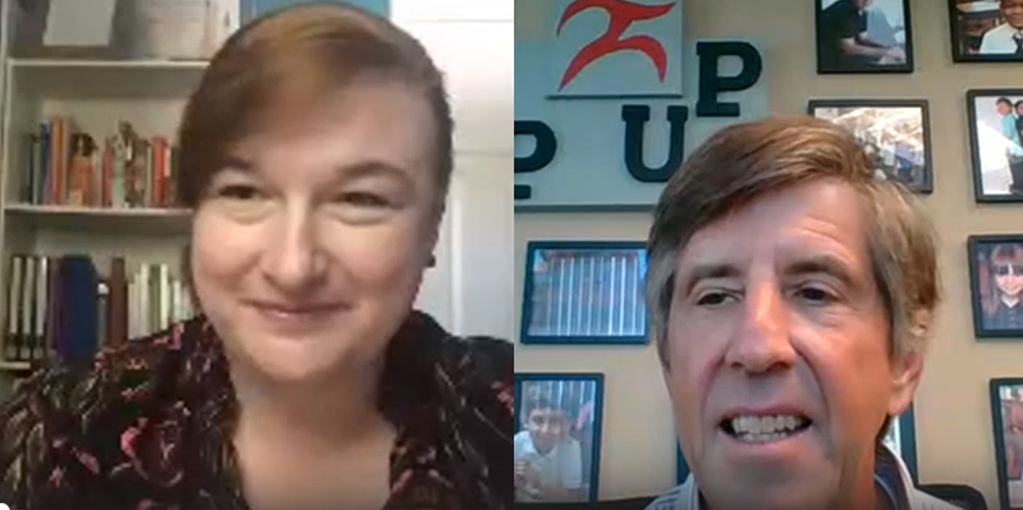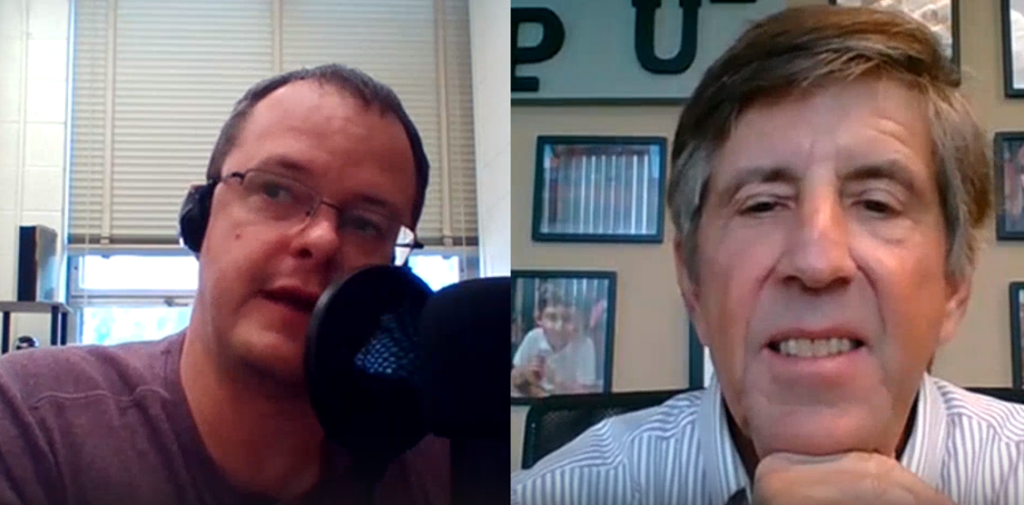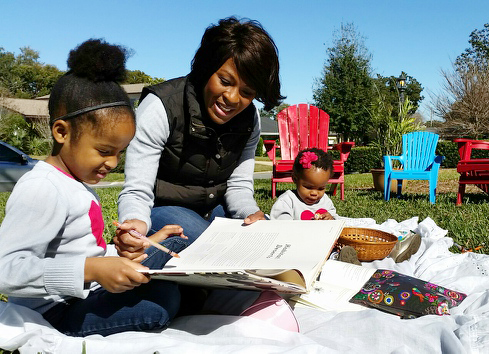
At Liberty Academy High School, learning is project and competency based with no traditional grades and no traditional seven-period day. Students are encouraged to work in small groups and interact frequently with teachers.
Editor’s note: You can watch videos of how Liberty Academy High School is rethinking education here and here.
A virtual tour of Liberty Academy High School in Liberty, Missouri, a suburb with a population of 30,167, is as notable for what you don’t see as much as for what is visible.
Instead of traditional classrooms crammed with desks, you’ll see multipurpose spaces with comfy chairs. The walls and ceilings are decorated with student artwork. Teachers collaborate with groups of students on projects and chat about goals for the day.
Rather than responding to a bell schedule, students move freely from area to area and are encouraged to come and go from campus as they practice the skills they’re learning in real life settings, thanks to agreements with more than 100 community business partners.

Social studies teacher Art Smith, right, believes strongly in each student's ability to pursue projects that interest them as a way to keep them focused on school.
Social studies teacher Art Smith, a 24-year veteran of Liberty Public Schools and a self-described “crazy guy,” redesigned the 26-year-old alternative high school’s format in 2016 with his colleagues so it would be more in line with what he calls “schools of the future.”
“We’re probably in a period of history where technology is allowing us to rethink schools,” said Smith, who doesn’t shy away from the title “education disruptor.”
During his career, Smith has tried almost every possible way to help kids derive meaning from what they’re learning, from carving canoes to building Conestoga wagons to staging archeological digs. He is among a rapidly expanding breed of educators who believe a break with the established educational model is necessary to improve the existing one.
Though Liberty Academy is a traditional district school, it looks and feels more like a public charter or private school with a model that draws inspiration from the unschooling movement of the 1960s, which encouraged exploration of activities initiated by students themselves. The basic idea is that the more personal learning is, the more meaningful it will be.
Here’s how it works. When students enter the program, they are allowed four weeks to determine their interests and long-term goals. Learning is then organized in six-week bursts of interest-based learning, which often includes participation with one of the school’s community partners in what school officials describe as “a reverse internship.”
Among the partners: a miniature horse farm, a greenhouse operation, cosmetology schools, a homeless shelter, and a host of nonprofit organizations. The aim is to allow students to explore careers, help others, and solve problems.
Students set goals based on three or four success skills during each segment. Teachers, who are referred to as advisers, help students document their growth each week and link their projects to standard and class credits.
At the end of each project, students give a presentation to a panel of at least three adults. At the end of each semester, they write an essay and display artifacts for a school and community showcase.
Learning is project based and competency based; there are no traditional grades and no traditional seven-period day. For staff members, it all adds up to an environment that looks more like life than school.
“Until you come and visit, it’s really hard to describe,” said Summer Kelly, Liberty Schools’ 2020-21 Teacher of the Year. (You can learn more about her here.) “I’m obviously a teacher, but I do way more than just teaching.”
A former middle school math teacher, Kelly left her traditional teaching job in the district three years ago to join the faculty at the alternative high school, which serves about 100 at-risk students.

Among the project-based activities available to students at Liberty Academy High is guitar building, which teaches math and engineering skills.
A typical day starts with physical activity, with a yoga class offered weekly. Afterward, students gather for a “circle meeting” and check in with their advisers and learn about trips available that day. Students then go out in small groups to participate with advisers.
“Nothing about our building is traditional in any way, and I think that’s where I needed the change,” Kelly said. “It gave me new motivation.”
Smith, the social studies teacher who helped redesign the school, said he came to a conclusion early in his career that school needed to look different to be effective, especially for students who don’t like going to school.
“They’re forced to be there, and they’re compliant and sitting in their classroom and sitting in their desks, but a lot of kids weren’t interested in anything happening on a day-to-day perspective, and that bothered me,” he said. “If they don’t love it and don’t feel intrinsically driven to be a part of it, then we should try to build a framework that does that, because no human wants to be a part of something that they don’t have ownership of and empowerment in.”
The school, which has the support of the district and school board, has won several awards and was named a grand prize winner in the 2020 Magna Awards sponsored by the National Association of School Boards. Other nearby districts have taken notice and are seeking to incorporate parts of Liberty Academy's model.
Said Smith: “We all feel blessed to be in this position at this time and to continue pushing the envelope of what school can be for kids.”
 On this episode, Tuthill talks with Riley, clinical professor of adolescent special education at Hunter College, about “learning through living.” Author of “Unschooling: Exploring Learning Beyond the Classroom,” Riley has direct experience with the topic, having been a 20-year-old self-determined mother who raised her son using this discipline.
On this episode, Tuthill talks with Riley, clinical professor of adolescent special education at Hunter College, about “learning through living.” Author of “Unschooling: Exploring Learning Beyond the Classroom,” Riley has direct experience with the topic, having been a 20-year-old self-determined mother who raised her son using this discipline.
Since then, she has become internationally known for her work in the fields of homeschooling, unschooling and self-directed learning, conducting extensive research on these topics. (See here, here and here.)
Tuthill and Riley discuss how interest in self-directed learning and intrinsic motivation is growing during the pandemic. Both believe the trend will continue as more families find value in a different approach to education, especially as technology continues to alter the way education works and looks.
"Unschoolers are so good at learning how to learn. If they don’t know something or haven’t come across something ... they know how to learn it, they learn how to do it."
EPISODE DETAILS:
· The history of unschooling and how it differs from homeschooling
· Research on unschooling outcomes and opinions on the model from parents and children who have participated
· Criticism of children “not knowing” what they need to learn and the non-linear nature of learning
· The possibility of making the benefits of unschooling available in a top-down model like a school district
LINKS MENTIONED:
Unschooling: Exploring Learning Beyond the Classroom
Research – The challenges and benefits of unschooling
Research – Grown unschoolers’ evaluation of their unschooling experience
Research – Grown unschoolers’ experience with higher education and employment
 In the first of a two-part discussion, Tuthill speaks with a premier thought leader on self-directed learning, also known as ‘unschooling.’ Currie-Knight, a teaching assistant professor at East Carolina University’s College of Education, supports education based on intrinsic motivation, or learning based on a child’s interests, which differs from more traditional education based on extrinsic motivation centering on grades and transcripts.
In the first of a two-part discussion, Tuthill speaks with a premier thought leader on self-directed learning, also known as ‘unschooling.’ Currie-Knight, a teaching assistant professor at East Carolina University’s College of Education, supports education based on intrinsic motivation, or learning based on a child’s interests, which differs from more traditional education based on extrinsic motivation centering on grades and transcripts.
Tuthill and Currie-Knight discuss Currie-Knight’s work with Pathfinder Community School, a learning environment in which children self-direct their instruction. They also discuss how unschooling often is dismissed as a privilege of the rich, an irony considering the critique most often is leveled by opponents of education choice.
“If you give kids freedom over their learning, expect them to be doing things all the time. At some point they're going to learn things ... People will be surprised at how tenaciously kids learn when they have a reason to."
EPISODE DETAILS:
· Self-directed learning and how kids figure out what they need to know
· What self-directed learning looks like on a day-to-day basis
· Changing two century-old perceptions on how children learn
· How COVID-19 has shifted education perceptions
· Criticisms of unschooling and their origin
LINKS MENTIONED:
Self-Directed Education and the Changing Shape of Knowledge
 As I talk with parents and educators who are struggling to create safe and effective learning options for their students, I’m taken with how many are revisiting the left-wing education reformers of the 1960s. Names like John Holt, Ivan Illich, A.S. Neill, and Paulo Freire are coming up so often that it feels like I’m back in graduate school.
As I talk with parents and educators who are struggling to create safe and effective learning options for their students, I’m taken with how many are revisiting the left-wing education reformers of the 1960s. Names like John Holt, Ivan Illich, A.S. Neill, and Paulo Freire are coming up so often that it feels like I’m back in graduate school.
It appears the 1960s leftist rationale for education choice is making a comeback.
A student columnist at my high school newspaper in 1971 introduced me to the radical ideas of educator John Holt. Holt inspired me to make improving public education my life’s work.
After working as an elementary and middle school teacher in the 1950s, Holt concluded that schools undermined children’s natural desires to learn, so he began promoting a form of homeschooling he called unschooling. Holt described the relationship between unschooling and student learning in his two most famous books, “How Children Fail” (1964), and “How Children Learn” (1967).
Unschooling aims to tap into children’s natural curiosity and desire to learn through authentic life experiences. Holt saw schools as artificial environments that undermine children’s natural desires to learn through exploration and play. Some of the current surge in homeschooling and micro-schools reflects Holt’s idea that learning should occur in more natural environments.
A recent New York Times column on educating children during this pandemic referred to the recent growing popularity of Ivan Illich’s concept of deschooling. Like Holt, Illich also felt that schools were artificial environments that stifled children’s innate desires to explore and learn. As the Times columnist observed:
“Deschooling’s core principles — that education should be self-directed rather than compulsory, that human growth and curiosity cannot be quantified and that children learn best in natural environments and mixed-age groups — have gained some recognition in recent years. But the idea of truly communitarian, noncompulsory, family-centered approaches to education were largely limited to the radical fringe of pedagogy. A lot has changed in six months.”
A.S. Neill’s 1960 book, “Summerhill,” is enjoying renewed popularity with families creating learning pods, micro-schools, and homeschool cooperatives. Consistent with Holt and Illich, Neill believed education should be centered on each child’s innate internal motivation to explore and learn. He created the Summerhill School in England to implement his beliefs that schooling should be less coercive and more democratic and child centered. Neill believe that schooling should be customized to fit the child instead of molding the child to fit the school.
Many education reformers today were directly or indirectly influenced by the Brazilian educator Paulo Freire. His 1968 book, “Pedagogy of the Oppressed,” was, and continues to be, must reading for anyone wanting to understand the politics of government-mandated education. While Holt, Illich, and Neill wrote about how the coercive and stressful nature of schooling negatively impacts students, Freire built on this analysis to explain how governments often use schools as instruments of social control and political oppression.
Freire promoted a liberation or critical pedagogy that empowers students and families to take control of their education and use it to attain greater political and economic freedom. While most parents exercising education choice today have not read Freire’s work, their motivations for asserting greater control over their child’s education increasingly reflect Freire’s ideas on the dangers of centralized, command and control public education systems.
Like many education choice advocates, I support the more democratic, child-centered approach to education that Holt, Illich, Neill, Freire, and others were promoting in the 1960s. But scaling up an education system capable of meeting the unique needs of each child is a daunting task, which is why most schools today still employ a one-size-fits-all, assembly line approach to teaching and learning.
This horrific pandemic has given families and micro-communities a unique opportunity to assume more control over how their children are educated. We need to give these families and their communities the support they need to be successful. Perhaps the hopes of the 1960s idealists will be realized and a more natural, child-centered way of educating our children will soon become the new norm.

Editor’s note: Kevin Currie-Knight, who authored this commentary, is a teaching assistant professor at East Carolina University’s College of Education. Currie-Knight’s research focuses on history, philosophy, and the politics of education.
These are strange and hard times. Across the world, schools are moving away from their temporary summer hiatus with no end in sight to COVID-19.
As a professor in a college of education who is quite familiar with research on how kids learn outside of conventional schools, I can offer six bits of advice to parents struggling with how to deal with children learning from home in either 100% virtual or hybrid settings. Before I give that advice, I have to carefully stress my awareness of how different this situation is from homeschooling (let alone unschooling or homeschooling without formal curriculum).
Most parents navigated the summer, and are now entering the new academic year, dealing with kids who are home from school not by choice but by necessity. For the past six months, schools and districts have fully expected their children to be learning and completing schoolwork. But this has not been, nor is it now, in any proper way been homeschooling.
Now that I’ve said that as carefully as I can, here are six points the literature on homeschooling and unschooling can nevertheless offer to families struggling with this new learn-at-home situation.
First, as tempting as it is, you might not need to stress as much as you think.
I know this one will be hard to hear, especially for families whose schools are expecting students to maintain a rigorous school schedule at home. Families are experiencing great pressure to replicate school at home and to make sure their kids are learning everything they can lest those kids fall behind.
Yet, there are four studies I know of that show that despite not learning in any “schooled” way, kids turn out fine in life. (Here, here, here, and a study summarized here.)
They get into college when they apply. They find decent jobs. All without the benefits of a traditional school education.
This is an admittedly small number of studies, and the studies themselves are small, but the results are quite consistent. Kids who don’t attend traditional schools tend to grow into adults who aren’t very distinguishable from their peers who learned in brick-and-mortar settings – and they certainly are not deficient.
It’s clear that families in this current crisis can’t treat it as a “just let them learn what they want” experience. But my message is more humble: For all of your anxiety about your kids’ sudden hiatus from in-person school, try not to stress about what will happen if you can’t replicate school at home, or what will happen if your child doesn’t learn everything your district expects to the standard children would have at brick-and-mortar school.
If these studies are to be believed – and I think we should believe them – your kids will almost certainly turn out fine. They will go on to be able to learn or relearn what they need when they need it.
Second, your job should be to ensure your children are learning, not necessarily to teach them.
A second source of stress for parents appears to be the idea that, without any warning, they now are supposed to be teachers. I would suggest that their job instead is to make sure their children can learn things. These two are (deceptively) different ideas.
To teach someone math means you become an expert in math and then convey your math expertise to learners. But to facilitate learning means to help the learner learn – to help them find resources and to ask them questions that might help them learn: “Well, what do you think went wrong? How can we figure out what went wrong? What resources can we use to figure that out?”.
In fact, this unfortunate hiatus from in-person school might be an interesting opportunity to empower kids to take more charge of their learning. Instead of having to learn things from and at the pace the teacher sets, parents can help their children find resources – books, friends or relatives who could help, online resources, anything – children can use to take more ownership of their own learning.
Yes, you can teach your kids too, if there are subjects you feel you know quite well that you can share with your children. But your main job is to help them learn in whatever ways you can, not necessarily to teach outright.
Third, kids don’t have to be learning all the time.
The important thing is simply that they learn, not the amount of time they spend learning. I’ve been reading a book called Rest: Why You Get More Done When You Work Less, by business writer Alex Soojung-Kim Pang. The author surveys literature that indicates contrary to what we often think, people tend to perform better when allowed time for rest.
And by rest, Pang means not only the type of passive rest most of us think of (watching television, sleeping) but active rest (pursuing hobbies and activities just for fun). As he puts it, “measuring time is literally the easiest way to assess someone’s dedication and productivity, but it’s also very unreliable.”
I see no reason why the research Pang cites wouldn’t also hold true for kids doing schoolwork. In fact, it is in line with what I’ve heard from both homeschoolers and unschoolers. Homeschoolers often start out thinking they will replicate school (and its daily schedule) at home but gradually find they get the best results by doing a few hours of academic work in the morning and allowing kids the rest of the day to pursue what interests them.
Unschoolers tend to report that a good amount of their (or their kids’) time is spent “doing nothing” before the learner finds something that really interests them. And once that happens, learning often will be quite rapid. A lot of learning is compressed into a small amount of time with ample opportunity to do things besides learning.
Again, parents are encouraged to take this advice only to the extent that it fits with the expectations of their district. But the lesson should be that you care more that they are learning, not how much time they spend learning, or that the time be equivalent to how much time they spend in school.
Fourth, more choice is better than less choice.
Obviously, most parents can’t let their kids have unlimited choice over what they learn, because schools and districts expect children to learn specific things. But a lot of research (here and here) shows that choice (autonomy) is a huge motivating factor in learning.
Try to give your kids as much choice as possible given the expectations of your school district and your own comfort level. Even if your district is giving your children large packets of work to complete each day or week, you can give them choice over the order in which they do it, the resources they use to complete it (maybe instead of using the textbooks or teacher’s slides, they can use YouTube or the Internet), and what times they do their work.
Fifth, learning doesn’t just happen in school-like ways.
School inadvertently gives us all the impression that learning is something that generally happens in school. (I’ve written about this before, cautioning that we think of math, science and history less as school subjects and more as ways of thinking.)
In traditional school settings, students learn math and history in math and history class, using math and history textbooks. But homeschoolers and unschoolers learn from a host of other sources. They can learn mathematical concepts while cooking, playing video games that use point systems and such, or playing with LEGOs. They can learn history by finding interesting documentaries or historical dramas to stream, calling relatives who have interesting stories to tell, or listening to podcasts.
And sometimes, learning even the most school-related stuff will just be a byproduct of unplanned activity, where children stumble across something that is interesting to them.
Most important, try to enjoy the time with your children.
Having kids unexpectedly home all day can surely be stressful. But it is also a great opportunity to develop connections with them that are less possible when they are in school (and we are at work) all day. And just as parents are stressed during times like these, so are kids. Now is a time where parents get to have conversations with kids, share their interests and allow them to share theirs.
This study of parents who don’t send their kids to traditional schools shows that a whopping 57% of those parents felt in retrospect like “family closeness” was a highly valuable part of having their kids home with them. Of course, those are families who chose (parents and kids) to not send the kids to school. Nevertheless, these families can teach us how parents and children can learn to see each other as allies and resources rather than adversaries.
So, we can take these strange times to get to know our kids in ways we couldn’t before, allow those of us who are working from home to see what their parents do all day and play (and learn) together.
It is true that we are not all homeschoolers and unschoolers now. To claim that we are would be like saying those displaced by natural disasters have become campers and outdoors enthusiasts. But just as veteran campers might have some words of wisdom for people navigating displacement, the literature on homeschooling and unschooling could have something to offer parents struggling in this difficult environment.